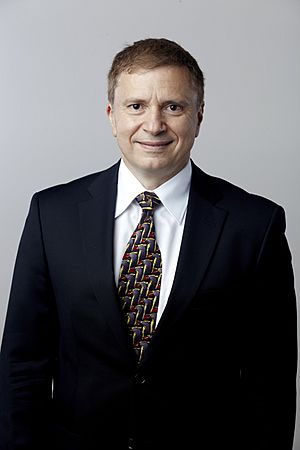Demetri Terzopoulos facts for kids
Quick facts for kids
Demetri Terzopoulos
FRS FRSC
|
|
|---|---|

Demetri Terzopoulos at the Royal Society admissions day in London, July 2014
|
|
| Awards |
|
| Website | terzopoulos |
| Alma mater |
|
| Known for |
|
| Spouse | Noemi Terzopoulos |
| Children | 2 |
| Scientific career | |
| Fields |
|
| Institutions | |
| Thesis | Multiresolution computation of visible-surface representations (1984) |
| Doctoral advisors |
|
Demetri Terzopoulos is a famous Greek-Canadian-American computer scientist. He is also an entrepreneur, which means he starts and runs businesses. He is currently a top professor at the University of California, Los Angeles (UCLA). There, he leads the UCLA Computer Graphics & Vision Laboratory.
Education and Early Life
Demetri Terzopoulos studied at McGill University in Canada. He earned his first engineering degree in 1978. He then got a master's degree in 1980. After that, he went to the Massachusetts Institute of Technology (MIT). In 1984, he earned his PhD in Artificial Intelligence. His research focused on how computers "see" and understand surfaces.
Career and Research Focus
After finishing his PhD, Terzopoulos worked at the MIT Artificial Intelligence Laboratory. He also worked at research centers for Schlumberger. He became a professor at the University of Toronto. Later, he taught at New York University. Since 2005, he has been a Chancellor's Professor at UCLA. In 2012, he became a Distinguished Professor, which is a very high honor.
Work in Healthcare AI
Since 2016, Terzopoulos has been a co-founder and Chief Scientist at VoxelCloud, Inc. This company uses AI in healthcare. They have offices in Los Angeles and Shanghai. He has also worked with many other important organizations. These include IBM, Intel, and the National Research Council of Canada.
Key Research Areas
Terzopoulos's main research areas are:
- Computer graphics: Making images and animations with computers.
- Computer vision: Teaching computers to "see" and understand images.
- Medical imaging: Using computers to analyze medical scans.
- Computer-aided design: Using computers to help design things.
- Artificial intelligence/Artificial life: Creating smart computer systems and simulations of living things.
He has written over 400 scientific papers. Many of these have won awards. He has also given more than 500 talks around the world.
Awards and Special Recognition
Demetri Terzopoulos has received many important awards for his work.
Guggenheim Fellowship
In 2009, he received a Guggenheim Fellowship. This award helps people do important research.
IEEE Computer Pioneer Award
In 2020, he won the IEEE Computer Pioneer Award. This award recognized his leading role in developing computer vision, graphics, and medical imaging. His work helped connect these fields.
Fellow of the Royal Society
He was elected a Fellow of the Royal Society (FRS) in 2014. This is a very high honor for scientists in the UK. The Royal Society noted his work on "active contours" (also called "snakes"). These are computer algorithms used in computer vision. They also recognized his work on "deformable models." These models help computers simulate how objects bend and move. His research also includes creating realistic computer simulations of humans and animals.
Helmholtz Prize
In 2013, he received a Helmholtz Prize. This was for a paper he wrote in 1987 called "Snakes: Active contour models". This paper was very important in the field.
IEEE PAMI Distinguished Researcher Award
In 2007, he received the first IEEE PAMI Computer Vision Distinguished Researcher Award. This was for his ongoing research on deformable models. He even created the term "Deformable Models."
Academy Award for Technical Achievement
In 2006, Demetri Terzopoulos won an Academy Award for Technical Achievement. He shared this award with John Platt. They were recognized for their work on making realistic cloth move in movies. Their 1987 paper on "Elastically deformable models" was a big step in computer graphics. It showed how to use physics to simulate moving and changing objects.
Fellow of the Royal Society of Canada
In 2006, he was elected a Fellow of the Royal Society of Canada. This award recognized him as a leader in computer vision and graphics. It also highlighted his work on deformable models.
Other Awards and Honors
Terzopoulos was also a Fellow of the Canadian Institute for Advanced Research (CIFAR). He received the E.W.R. Steacie Memorial Fellowship from Canada. He also won the Killam Research Fellowship. He has received awards for his contributions to image understanding and computer graphics. In 1973, he received the Governor General's Academic Medal.
See also
- Active contour model

